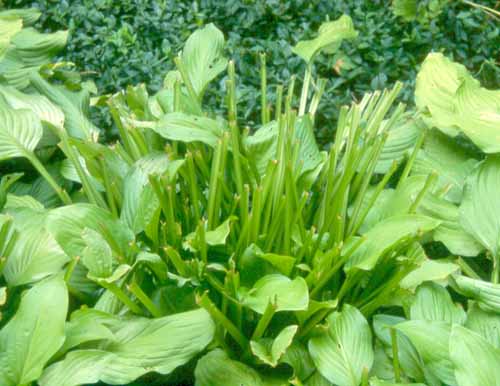 There was a time when deer were creatures of the forests
and wild areas. In recent decades as people have invaded their
habitat, deer have adapted to life in the suburbs. In fact
they also pester urban gardeners. There was a time when deer were creatures of the forests
and wild areas. In recent decades as people have invaded their
habitat, deer have adapted to life in the suburbs. In fact
they also pester urban gardeners.
As with
slugs, to reduce a deer problem, you can attack one
or more of three factors:
|
|
 |
Deer eat the leaf blade and
leave the petiole (leaf stalk) so that the clump looks like
a bunch of celery sticking into the air. If rabbits nibble
on a hosta leaf, of course, they must be down lower on the
plant due to the size of the critter.
|
|
 |
- Get Rid of the Deer
- Change the Growing Environment
- Reduce the Food Supply
|
|
 |
|
Getting Rid of the
Deer |
 In most urban or suburban situations, reduction of the deer
herd by individual gardeners is not an option. State wildlife
agencies have been trying to manage deer herds for decades
with little or no impact. The number of deer in most areas is
on the rise. So, we need to look at other alternatives for
ways to protect our beloved hostas. In most urban or suburban situations, reduction of the deer
herd by individual gardeners is not an option. State wildlife
agencies have been trying to manage deer herds for decades
with little or no impact. The number of deer in most areas is
on the rise. So, we need to look at other alternatives for
ways to protect our beloved hostas.
|
|
 |
| Change the Growing
Environment |
Deer need places to eat, sleep, drink, reproduce and feel
safe. Sometimes we can change the local environment such that
the deer are excluded from an area. For pure exclusion, a
fence needs to be about 10 feet tall and leaning away from the
area to be protected. However, deer tend to shy away from
areas where they cannot determine a safe escape route.
Planting a row of shrubs on both sides of a shorter (six feet
or so) solid fence may block enough of their site to make them
leery of the area.
Some people have had success with common electric fences that
are used for farm livestock. These are available now with
solar powered units. The key with these fences is that you
need to be isolated a bit from neighbors to prevent accidental
contact by small children. And, it seems that multiple strand
fences work best.
Even electric fences, however, seem to be dependent on the
"take off and landing" space available. If they have a clear
way on both sides of the fence, deer can leap over most
electric fences. By cluttering up the landing zone with
plants, hardscape or some other obstacle, the success of the
fence may increase.
Wolves are natural enemies of deer. Most of us do not have a
wolf but we have the next best thing, a dog. People with large
gardens have had success using "invisible fence" products to
restrict the range of the dogs to the boundaries of their
properties. Leave the dogs out at night and they will chase
away any deer that wander in looking for a snack.
|
|
 |
| Reduce the Food Supply |
Food
- As with slugs,
you will often see lists of "deer resistant" hostas or other
plants. These are good for a general indication but actual
results may vary widely from garden to garden. A site where 3
deer wander across the yard every week or so will have much
different impacts than one where 20 deer walk through every
night of the summer.
|
|
 |
|
Repellants |
Whether
home made or commercially prepared, repellants are meant to
make potential food either taste or smell bad to the deer (or
rabbits). There are several commercially available repellants
on the market. The down side of all of them is that they wash
off with rain or irrigation. They generally work while on the
plant but need regular replacement.
To minimize the number of time you must reapply, try using an
additive called a "sticker, spreader." A drop or two of this
product per gallon of repellant spray will make it spread
better on the leaf and bond better. Thus, it will generally
extend the effective time of the repellant.
A number of homemade repellant sprays are also used by hosta
gardeners. Pepper sprays, garlic juice, the urine of predator
animals, Milorganite and others are used to deter deer. All
work to a certain degree until they wear out. Human hair is
often used too but, with deer that are accustomed to living
around people, its effectiveness is diminished.
Soap is an effective repellant also. Small bars of soap spread
around the garden may help to keep the deer away.
|
|
 |
|
Scare the Deer |
Deer like to be comfortable in their environment. They do
not like surprises. To take advantage of this characteristic,
there are several devices available today. One is a motion
detector unit that is attached to a water spray nozzle. When a
deer comes near the garden, the water comes on and spooks them
away. Some times the motion detector is connected to a sound
device or a bright light.
Often the key to the effectiveness of these options is to move
the device every week or so. If they are left in the same
spot, even the deer will eventually become acquainted with
them and merely feed in another part of your garden.
|
|



